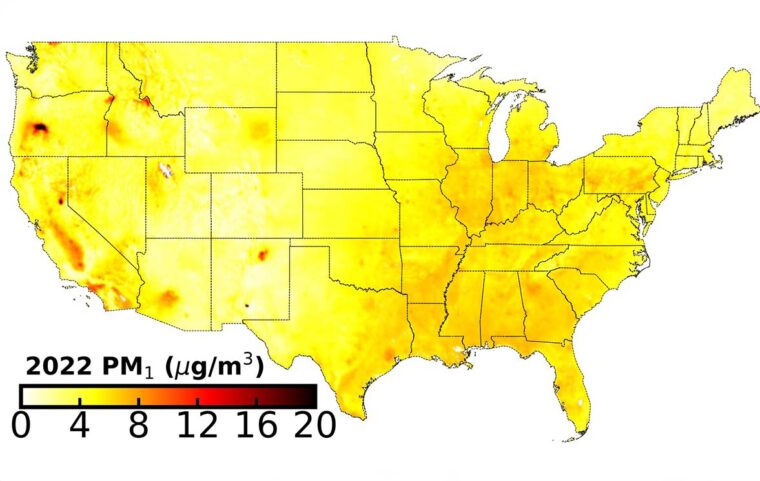2025-06-16 ワシントン大学セントルイス校
 Researchers at WashU determined the concentration of submicron particulate matter over the United States, with the darker red areas holding higher concentrations. These are the smallest particles of air pollution, which could make them more detrimental to human health. (Image courtesy of Atmospheric Composition Analysis Group)
Researchers at WashU determined the concentration of submicron particulate matter over the United States, with the darker red areas holding higher concentrations. These are the smallest particles of air pollution, which could make them more detrimental to human health. (Image courtesy of Atmospheric Composition Analysis Group)
<関連情報>
- https://source.washu.edu/2025/06/tiny-and-toxic-researchers-track-smaller-air-pollution-particles-across-us-skies/
- https://engineering.washu.edu/news/2025/Tiny-and-toxic-Researchers-track-smaller-air-pollution-particles-across-US-skies.html
- https://www.thelancet.com/journals/lanplh/article/PIIS2542-5196(25)00094-4/fulltext
1998年から2022年までの米国大陸におけるサブミクロン粒子状物質(PM1)濃度の推定:PM1の測定と全国的なPM2-5成分データの活用 Estimates of submicron particulate matter (PM1) concentrations for 1998–2022 across the contiguous USA: leveraging measurements of PM1 with nationwide PM2·5 component data
Chi Li, PhD ∙ Prof Randall V Martin, PhD ∙ Aaron van Donkelaar, PhD ∙ Prof Jose L Jimenez, PhD ∙ Prof Qi Zhang, PhD ∙ Prof Jay R Turner, DSc ∙ et al.
The Lancet Planetary Health Published June 2025
DOI:https://doi.org/10.1016/S2542-5196(25)00094-4
Summary
Background
Excess health risk estimates of exposure per unit mass concentration of fine particulate matter (PM2·5) still exhibit a wide range, potentially due to variations in aerosol size and composition. Submicron particulate matter (PM1) was recently reported to exert stronger health impacts than PM2·5 from studies in China, but an absence of long-term PM1 data in the USA has prohibited such investigations despite a wealth of cohorts. This study aims to fill this data gap and estimate PM1 concentrations over 1998–2022 across the USA.
Methods
We estimated biweekly gapless ambient PM1 concentrations and their uncertainties at 1 km2 resolution across the contiguous USA over the 25-year period of 1998–2022, from hybrid estimates of PM2·5 chemical composition that merged information from satellite retrievals, air quality modelling, and ground-based monitoring. The mass fractions of PM2·5 components with diameters below 1 μm were constrained by observations for four major components and from established scientific understanding for the other components.
Findings
PM1 concentrations exhibited pronounced spatial variation across the contiguous USA with enhancements observed in the east, major urban and industrial areas, and areas affected by wildfires; low concentrations are prevalent over the arid west. The main components of population-weighted mean (PWM) PM1 in 2022 (6·1 μg/m3) were organic matter (47%), sulphate (22%), nitrate (12%), black carbon (8%), and ammonium (7%). The biweekly PM1 estimates were highly consistent with independent ground-based PM1 measurements (slope=0·96, R2=0·78). The estimated 1-σ uncertainties of annual mean PM1 for the 25 years over more than 8 million land pixels were less than 20% for 98% of data points, while 0·3% of the population of the contiguous USA was associated with uncertainties of more than 30% due to wildfires. The PWM PM1 decreased significantly (p<0·0001) at a rate of –0·23 μg/m3 per year during 1998–2022, accounting for 86% of the overall reduction of PWM PM2·5; the PWM PM1/PM2·5 ratio experienced simultaneous decrease (–0·0013 per year, p<0·0001).
Interpretation
The dominance of PM1 in PM2·5 reduction and the decreasing PM1/PM2·5 ratio reflect the strong association of PM1 with fossil fuel and other combustion sources and their responses to air quality regulations during the 25-year study period. The gradual coarsening of PM2·5 calls for increasing urgency to separately assess health impacts of PM1 versus PM2·5, as supported by the quality of the derived PM1 estimates. Future particulate matter monitoring programmes, health studies, and regulatory deliberations should consider PM1 in addition to PM2·5.
Funding
National Institute of Environmental Health Sciences, National Institutes of Health.



